Bibliography Background About KRIS
Relating Sensitive Amphibians and Forest Stand Conditions: NW California Regional Examples
Dr. Hartwell Welsh at Redwood Sciences Lab, the U.S. Forest Service Research Station in Arcata, has studied sensitive amphibians and the relationship of health of populations to forest stand conditions. Much of the data comes from work in progress in the Mattole River basin on the relationship between the diversity of amphibian species and the seral stage of the stream canopy. Key charts of these relationships can be found below showing examples based on Mattole data as well as those based on regional data. In between are photos of various kinds of Mattole riparian habitat and streams surveyed.
Late Seral Forest Types
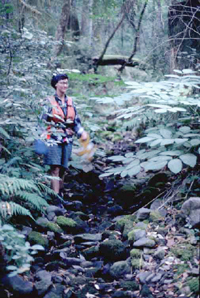
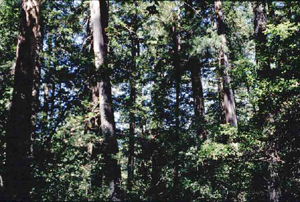 Dream Stream is a small, second order headwater tributary to the Mattole River. It joins the Mattole above Whitethorn. The watershed is mostly late seral forest. The small, well-shaded stream is the type of habitat that could support tailed frogs and southern torrent salamanders. A multi-tiered canopy keeps water temperatures mostly between 10-14 C, which is optimal for tailed frogs. Humidity also remains high which is necessary for these amphibians because they breath through their skin.
Dream Stream is a small, second order headwater tributary to the Mattole River. It joins the Mattole above Whitethorn. The watershed is mostly late seral forest. The small, well-shaded stream is the type of habitat that could support tailed frogs and southern torrent salamanders. A multi-tiered canopy keeps water temperatures mostly between 10-14 C, which is optimal for tailed frogs. Humidity also remains high which is necessary for these amphibians because they breath through their skin.
Second Growth Forest Types in the Mattole River Basin
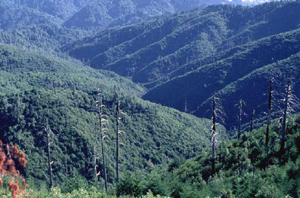 Noonan Creek drains the Kings Range and joins the Mattole from the west, downstream of the Shelter Cover Road. There was extensive timber harvest in Noonan Creek in the 1950s and 1960s, followed by a stand-replacing fire in the mid-1970s. This watershed is an example of second growth forest without interspersed grasslands.
Noonan Creek drains the Kings Range and joins the Mattole from the west, downstream of the Shelter Cover Road. There was extensive timber harvest in Noonan Creek in the 1950s and 1960s, followed by a stand-replacing fire in the mid-1970s. This watershed is an example of second growth forest without interspersed grasslands.
Mixed Second Growth and Grasslands
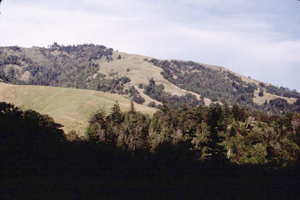 Conklin Creek, a Mattole river tributary, drains mélange terrain, which leads to a high component of natural grasslands. Grasslands may have been somewhat expanded by grazing after timber was harvested in the watershed. Streams flowing from mixed grassland/forest ecosystem tend to be too warm to support tailed frogs and torrent salamanders.
Conklin Creek, a Mattole river tributary, drains mélange terrain, which leads to a high component of natural grasslands. Grasslands may have been somewhat expanded by grazing after timber was harvested in the watershed. Streams flowing from mixed grassland/forest ecosystem tend to be too warm to support tailed frogs and torrent salamanders.
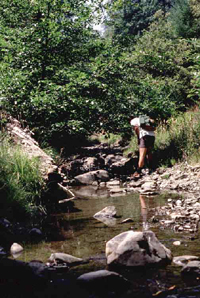 This unnamed creek joins the Mattole River just downstream from Little Finley Creek. The watershed is mixed grassland and second growth forest. Although torrent salamanders were once collected from this stream by the University of California, they are no longer found here. Canopy removal has pushed stream temperatures into lethal ranges for both tailed frogs and southern torrent salamanders. See water quality (WQ) Topics in the Mattole Basin of KRIS Coho for more on temperature and survival of these species.
This unnamed creek joins the Mattole River just downstream from Little Finley Creek. The watershed is mixed grassland and second growth forest. Although torrent salamanders were once collected from this stream by the University of California, they are no longer found here. Canopy removal has pushed stream temperatures into lethal ranges for both tailed frogs and southern torrent salamanders. See water quality (WQ) Topics in the Mattole Basin of KRIS Coho for more on temperature and survival of these species.
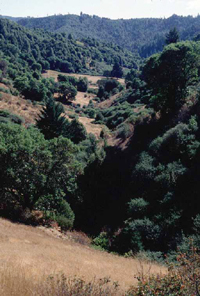 The Sweethome Creek watershed has components of natural grassland and some forested areas have also been converted to grazing lands. The stream segment in the center of the photo shows a sparse riparian area which allows the stream to heat substantially. Tailed frogs and southern torrent salamanders are almost never found in these habitats but yellow-legged frogs are usually abundant.
The Sweethome Creek watershed has components of natural grassland and some forested areas have also been converted to grazing lands. The stream segment in the center of the photo shows a sparse riparian area which allows the stream to heat substantially. Tailed frogs and southern torrent salamanders are almost never found in these habitats but yellow-legged frogs are usually abundant.
From the Mattole River Basin
Extensive temperature surveys, conducted in conjunction with amphibian surveys show a correlation between air temperatures in riparian zones of various seral stages and water temperature. These charts reveal a key limiting factor for tailed frogs and torrent salamanders, which have little tolerance for thermal pollution.
Air temperatures vs. distance from stream for three forest types
Abundance of Black Salamanders in perennial and intermittent streams
Richness of amphibian species in 3 forest cover types
From Regional Studies
Number of tailed frogs plotted against age of forest and air temperature (45 KB)
Abundance of So. torrent Salamander vs. % canopy
